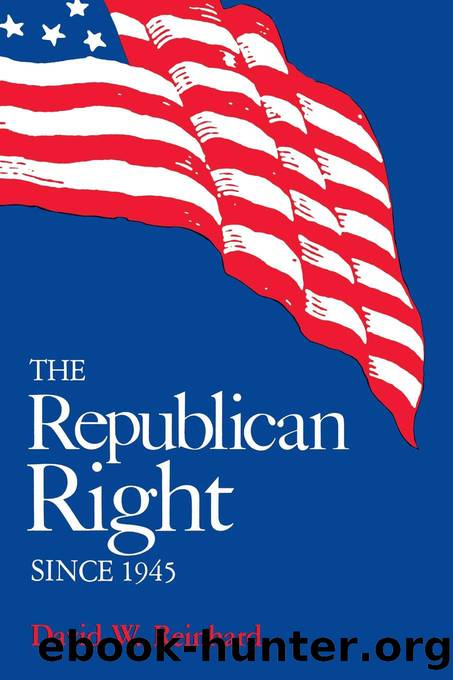The Republican Right Since 1945 by Unknown

Author:Unknown
Language: eng
Format: epub
Publisher: University Press of Kentucky
Published: 2011-04-15T00:00:00+00:00
9
A Choice Not an Echo
The Republican Right had finally found a pin-up boyâSenator Barry M. Goldwater of Arizona. Goldwater presidential talk for 1964 had begun even before election day 1960. Indeed, the senator himself took time off from stumping for the Nixon-Lodge ticket to say that he might run in 1964 should Nixon fall short in 1960. After Nixonâs electoral defeat, Goldwater emerged as the spokesman of GOP conservatism, promising âto spend the next four years discovering why the conservative majority of this country has no effective voice against the radical minorityâand doing something about it.â1
Goldwater did that and more in the next few years. On television talk shows and the lecture circuit, in magazine feature stories and his own writings, Goldwater set forth the conservative Republican credo. The GOP had no more popular after-dinner speaker. Goldwaterâs newspaper column âHow Do You Stand, Sir,â started in 1960 in the Los Angeles Times, was carried by 162 other newspapers by 1962. His books quickly became bestsellers. The Republican Rightâso long without an attractive advocateânow boasted Barry Goldwater, the self-styled âsalesmanâ of the conservative view.
This being politics, the salesman quickly became synonymous with the product. Goldwater-for-President buttons began to appear everywhere. By mid-1961, a poll of 1960 GOP convention delegates and alternates showed Goldwater to be their overwhelming favorite; 49.3 percent wanted Goldwater to top the Republican ticket in 1964, while only a combined 44.4 percent favored either Nixon or Rockefeller instead. Time called the Arizona senator âthe hottest political figure this side of Jack Kennedy.â2
Indeed, in an age of image and charisma, Senator Goldwater stood as the perfect GOP match against President John F. Kennedy. Goldwater had âit.â Tall and tan with a handsome, ruggedly sculptured face, dark hornrimmed glasses, and wavy gray-white hair, Goldwater looked like a president. The Arizonan was so handsome, Senator Hubert Humphrey once spoofed, that he had landed a Hollywood movie contractâwith 18th Century-Fox. Even more than his good looks, Goldwater had both tremendous charm and energy or, as it was then called, âvigor.â He not only flew jet planes, but, like Kennedy, he also wrote books. If Goldwater was not JFKâs oratorical equal, he was at least an effective speaker in informal settingsâhis easy, colloquial manner ably communicating his quiet sincerity.
Comparisons between this new darling of the Republican Right and Robert Taft were also inevitable. Goldwater was the first real leader of the Republican Right since Taft. Through the difficult 1950s, Right Wing Republicans had remained âTaft Republicansââa reflection on the state of the Republican Right and William F. Knowlandâs spiritless leadership. By 1960, however, GOP candidates were beginning to bill themselves as âGoldwater Republicans.â
But Goldwater and Taft each dominated the Republican Right in different ways. If Goldwater was the salesman of conservative Republicanism, Robert Taft had been its legislator. Unlike Taft, Goldwater had no major piece of legislation bearing his name. Taft had had his greatest influence in the Senate, where Goldwater, though a member of the Senate âclub,â was hardly a ruling member. Goldwater Republicanism was, in fact, strongest in the House of Representatives.
Download
This site does not store any files on its server. We only index and link to content provided by other sites. Please contact the content providers to delete copyright contents if any and email us, we'll remove relevant links or contents immediately.
The Secret History by Donna Tartt(18082)
The Social Justice Warrior Handbook by Lisa De Pasquale(11940)
Thirteen Reasons Why by Jay Asher(8414)
This Is How You Lose Her by Junot Diaz(6409)
Weapons of Math Destruction by Cathy O'Neil(5798)
Zero to One by Peter Thiel(5459)
Beartown by Fredrik Backman(5304)
The Myth of the Strong Leader by Archie Brown(5215)
The Fire Next Time by James Baldwin(4998)
How Democracies Die by Steven Levitsky & Daniel Ziblatt(4940)
Promise Me, Dad by Joe Biden(4898)
Stone's Rules by Roger Stone(4831)
100 Deadly Skills by Clint Emerson(4660)
Rise and Kill First by Ronen Bergman(4535)
A Higher Loyalty: Truth, Lies, and Leadership by James Comey(4532)
The David Icke Guide to the Global Conspiracy (and how to end it) by David Icke(4359)
Secrecy World by Jake Bernstein(4354)
The Farm by Tom Rob Smith(4303)
The Doomsday Machine by Daniel Ellsberg(4230)
